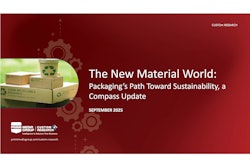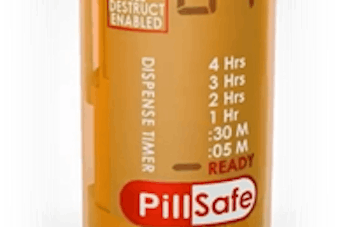
The International Safe Transit Association met in Denver last week for TransPack and TempPack, co-located conferences addressing issues facing today’s packaging and logistics professionals in both consumer packaged goods and cold-chain pharmaceuticals.
Green opened the conference explaining how supply chain woes have led IBM to use the cloud to track not only the location of mainframe computer shipments, but the health of those shipments as well. (See article here.)
He then went on to offer a basic primer on blockchain technology for logistics. Blockchain for business, said Green, reinforces organizational trust with algorithmic trust. It’s distributed, permissioned and secure, said Green.
Blockchain is a shared form of record keeping where no one person holds ownership of the information. No one person can add or alter the information in any way without creating a permanent record of the transaction.
An initial block is created for the goods as they leave the factory, initiating the blockchain. This block contains the details like time, quantity of goods, type, and the transport company’s confirmation of goods received. A new block is then added for each step in the journey until the goods reach their final destination.
It eliminates risk of fraud or error with records that cannot be deleted or hacked. “We believe blockchain will do for business what the internet did for information,” said Green.
Six characteristics make blockchain particularly good for moving product and keeping track of shipments.
- Immutability: provides integrity to the data so references and audits are available and manageable.
- Irreversibility: reduces audit cost.
- Smart Contracts: issue payment when certain conditions are met, and automatically check the product in the supply chain.
- Decentralized network/distributed ledger: Inherent in blockchain.
- Consensus based: reduces disputes between parties
- Reconciliation: auditability reduces reconciliation costs.
How can blockchain help the Internet of Things?
- Track connected devices in the network
- Authenticate users and devices
- Maintain data security
- Remove single point of failure
- Build trust between processes
- Reduce cost by eliminating intermediaries
Blockchain adoption is still early, says Green, but interest continues to grow and applications are varied. Customers are demanding to be connected with real-time data on product health and location and blockchain promises reductions in paperwork and cybercrime, and offers accountability.
Green referenced a short (3:30) Youtube clip from IBM on Basics of Blockchain. View here.
ISTA’s Omni-Channel Packaging Strategies Conference will take place in Chicago, Oct. 2-3.
The International Safe Transit Association met in Denver last week for TransPack and TempPack, co-located conferences addressing issues facing today’s packaging and logistics professionals in both consumer packaged goods and cold-chain pharmaceuticals.
Green opened the conference explaining how supply chain woes have led IBM to use the cloud to track not only the location of mainframe computer shipments, but the health of those shipments as well. (See article here.)
He then went on to offer a basic primer on blockchain technology for logistics. Blockchain for business, said Green, reinforces organizational trust with algorithmic trust. It’s distributed, permissioned and secure, said Green.
Blockchain is a shared form of record keeping where no one person holds ownership of the information. No one person can add or alter the information in any way without creating a permanent record of the transaction.
An initial block is created for the goods as they leave the factory, initiating the blockchain. This block contains the details like time, quantity of goods, type, and the transport company’s confirmation of goods received. A new block is then added for each step in the journey until the goods reach their final destination.
It eliminates risk of fraud or error with records that cannot be deleted or hacked. “We believe blockchain will do for business what the internet did for information,” said Green.
Six characteristics make blockchain particularly good for moving product and keeping track of shipments.
- Immutability: provides integrity to the data so references and audits are available and manageable.
- Irreversibility: reduces audit cost.
- Smart Contracts: issue payment when certain conditions are met, and automatically check the product in the supply chain.
- Decentralized network/distributed ledger: Inherent in blockchain.
- Consensus based: reduces disputes between parties
- Reconciliation: auditability reduces reconciliation costs.
How can blockchain help the Internet of Things?
- Track connected devices in the network
- Authenticate users and devices
- Maintain data security
- Remove single point of failure
- Build trust between processes
- Reduce cost by eliminating intermediaries
Blockchain adoption is still early, says Green, but interest continues to grow and applications are varied. Customers are demanding to be connected with real-time data on product health and location and blockchain promises reductions in paperwork and cybercrime, and offers accountability.
Green referenced a short (3:30) Youtube clip from IBM on Basics of Blockchain. View here.
ISTA’s Omni-Channel Packaging Strategies Conference will take place in Chicago, Oct. 2-3.
The International Safe Transit Association met in Denver last week for TransPack and TempPack, co-located conferences addressing issues facing today’s packaging and logistics professionals in both consumer packaged goods and cold-chain pharmaceuticals.
Green opened the conference explaining how supply chain woes have led IBM to use the cloud to track not only the location of mainframe computer shipments, but the health of those shipments as well. (See article here.)
He then went on to offer a basic primer on blockchain technology for logistics. Blockchain for business, said Green, reinforces organizational trust with algorithmic trust. It’s distributed, permissioned and secure, said Green.
Blockchain is a shared form of record keeping where no one person holds ownership of the information. No one person can add or alter the information in any way without creating a permanent record of the transaction.
An initial block is created for the goods as they leave the factory, initiating the blockchain. This block contains the details like time, quantity of goods, type, and the transport company’s confirmation of goods received. A new block is then added for each step in the journey until the goods reach their final destination.
It eliminates risk of fraud or error with records that cannot be deleted or hacked. “We believe blockchain will do for business what the internet did for information,” said Green.
Six characteristics make blockchain particularly good for moving product and keeping track of shipments.
- Immutability: provides integrity to the data so references and audits are available and manageable.
- Irreversibility: reduces audit cost.
- Smart Contracts: issue payment when certain conditions are met, and automatically check the product in the supply chain.
- Decentralized network/distributed ledger: Inherent in blockchain.
- Consensus based: reduces disputes between parties
- Reconciliation: auditability reduces reconciliation costs.
How can blockchain help the Internet of Things?
- Track connected devices in the network
- Authenticate users and devices
- Maintain data security
- Remove single point of failure
- Build trust between processes
- Reduce cost by eliminating intermediaries
Blockchain adoption is still early, says Green, but interest continues to grow and applications are varied. Customers are demanding to be connected with real-time data on product health and location and blockchain promises reductions in paperwork and cybercrime, and offers accountability.
Green referenced a short (3:30) Youtube clip from IBM on Basics of Blockchain. View here.
ISTA’s Omni-Channel Packaging Strategies Conference will take place in Chicago, Oct. 2-3.
The International Safe Transit Association met in Denver last week for TransPack and TempPack, co-located conferences addressing issues facing today’s packaging and logistics professionals in both consumer packaged goods and cold-chain pharmaceuticals.






















